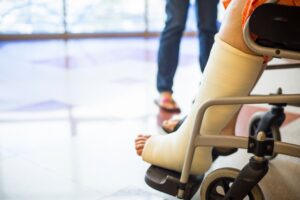How Do You Claim For An Injured Leg In A Hospital?
This guide tells you how to make a public liability claim if you have injured your leg in a hospital as a visitor. Our guide will give you the steps and advise that you need to start claiming compensation if your injury was the hospital’s fault.
To determine whether you have a valid claim, we state the eligibility criteria which you must fulfil in order to begin the claims process. We then discuss possible examples of how you could injure your leg in a hospital as a visitor.
Furthermore, this guide informs you of the best types of evidence you can collect to make your claim strong. Plus, we explore some possible guideline compensation values for personal injury claims and provide examples of what you could include in your claim.

Claims Guide For An Injured Leg In A Hospital
Continue reading until the end of this guide to find out how our panel of No Win No Fee solicitors can be useful for you throughout the whole claims process. If you wish to make a public liability claim, please get in touch with us, and we can see whether we can connect you to a No Win No Fee solicitor. You can get in touch with us through one of the following methods:
- Call 020 3870 4868.
- Using our Claim Online form.
- Messaging in our live chat feature.
Browse Our Guide
- How Do You Claim For An Injured Leg In A Hospital?
- How Can Accidents And Injuries Happen In Hospitals?
- Proving The Hospital Was Liable For Your Injuries
- How Much Could You Claim For An Injured Leg In A Hospital?
- Why Choose Us For No Win No Fee Hospital Injury Claims?
- Discover More About Injury Claims
How Do You Claim For An Injured Leg In A Hospital?
You may be able to claim compensation for being injured in an accident in a public place if a duty of care that was owed to you was broken.
All occupiers (anyone who has control) of a public building, outdoor space, premises, etc. have a duty of care to take steps to ensure the reasonable safety of those who are using the space as it’s designed for. This legal responsibility is in the Occupiers’ Liability Act 1957.
Occupiers can and should adhere to their duty of care by regularly risk assessing their space, implementing health and safety procedures, and fixing hazards.
So, to have a valid claim, you have to meet and show the following personal injury claims eligibility criteria:
- You were owed a duty of care.
- This duty was breached.
- This breach caused you to have an injury.
Therefore, you should contact us if you have injured your leg in a hospital and you believe it to be because of the occupier breaching their legal duty of care. By having a chat with us about your case, we can authenticate the eligibility of your public liability claim and potentially appoint you a solicitor from our panel. The next section focuses on some examples of how an occupier’s duty of care could be breached, causing a visitor to be injured in a hospital.
Time Limits On Public Accident Claims
The Limitation Act 1980 sets the limitation period for personal injury claims.
You have 3 years to begin making a public liability claim, commencing from the day that you were injured.
However, there are exceptions to the time limitation period if the claimant was younger than 18 when they were injured or if they lack the mental capacity to be able to make a claim. For more information about the public accident claims time limit and its exceptions, you can contact us.
How Can Accidents And Injuries Happen In Hospitals?
There are different ways in which a public liability accident could cause a visitor to suffer an injured leg in a hospital. Let’s take a look at some examples:
- Slips, trips, and falls. For example, a nurse spilt a jug of water in the hospital corridor but forgot to put down any wet floor signs to warn people of the slip hazard because they got preoccupied. A visitor then walks along and slips and falls on the spillage, leading to a fractured leg.
- Defective objects. For example, a visitor is in the waiting room of a hospital. One of the legs of the chair is broken, and it has not been removed or replaced, so when they sit down, the chair collapses, trapping their leg in a crush injury.
- Poor lighting. For example, there is inadequate lighting in one of the stairwells in the hospital. Despite a number of staff and patients reporting this problem, the occupier has not fixed the lights. Therefore, a visitor falls down the stairs since they cannot see their footing, causing them to have a broken leg.
If you want to verify liability for the accident that caused you to suffer an injured leg in a hospital, don’t hesitate to get in touch with us today.
Proving The Hospital Was Liable For Your Injuries
Not all accidents that cause an injured leg in a hospital will mean the injured person is eligible to make a public liability claim. First and foremost, as the eligibility criteria state above, the accident that caused your injury must have resulted because the occupier breached their duty of care. So you will need to provide evidence not only of this but also of how the injury resulted from this and its impacts on you.
Thus, try and gather the following:
- Footage from a hospital CCTV camera that shows the accident.
- Photographs of the accident scene and your injury.
- Footage from a dash-cam or similar device if the incident happened outside but still on hospital grounds, such as in the car park.
- A copy of the accident report logbook.
- Recording your symptoms and well-being in a dated diary.
- If anyone was a witness to the accident, take their contact details.
- Request copies of your medical reports, like a copy of an X-ray or scan.
If we do appoint you, a solicitor from our panel, they will help take some of the stress off your shoulders by collecting your evidence with you.
How Much Could You Claim For An Injured Leg In A Hospital?
If you make a public liability claim for your injured leg in a hospital, and your claim is successful, you may receive up to two Heads of Loss in your personal injury compensation to compensate for the different impacts of your injury.
General damages, the primary award, covers the physical and psychological harm you have suffered. Such factors that are looked at when calculating your general damages include:
- Your pain severity.
- How your quality of life is.
- How long your recovery period is.
Whoever calculates the payout will also refer to the guidelines from the Judicial College (JCG), together with an independent medical assessment report. Within the JCG are varying guideline compensation brackets for different sorts of injuries.
Injuries Table
We have included some leg injuries taken from the JCG together with its stated guideline compensation brackets. Since these are guideline figures only, the potential amount of compensation you may receive will be unique.
| Injury | Severity | Guideline compensation bracket | Notes |
|---|---|---|---|
| Multiple serious injuries plus the financial losses they cause. | Severe | Up to £500,000+ | Injuries of a serious nature to multiple body parts plus costs such as home care or loss of earnings. |
| Leg | Amputation (a) (iii) | £104,830 to £137,470 | Where above-knee amputation has taken place. |
| Severe (b) (i) | £96,250 to £135,920 | Where extensive bone grafting has been undertaken due to leg fractures not uniting | |
| Severe (b) (ii) | £54,830 to £87,890 | Very serious injuries leading to the injured person needing mobility aid for the rest of the injured person’s life. | |
| Severe (b) (iii) | £39,200 to £54,830 | Serious ligament injuries and fractures leading to prolonged treatment and instability. | |
| Severe (b) (iv) | £27,760 to £39,200 | Cases including severe crushing injuries or complicated fractures. | |
| Less serious (c) (i) | £17,960 to £27,760 | Fractures injuries from which not a complete recovery is made. |
The top entry of the table is not part of the JCG.
Further Examples Of Damages
Special damages, the secondary head of claim, may pay you for the expenses your leg injury has cost you. Such costs you may have from your leg injury include:
- Your travel to and from appointments.
- Over-the-counter pain relief medication.
- Lost wages if you cannot work during your recovery.
It is vital that you keep proof of your injury’s costs. Proof can be in the form of bank statements, invoices, receipts, and payslips.
If you contact us, we can tell you more about what goes into deciding compensation awards for personal injury claims.
Why Choose Us For No Win No Fee Hospital Injury Claims?
To find out if you could make a public liability claim for an injury that happened while visiting a hospital, call our advisors now for a free case assessment. If they can see that you have valid grounds to make a personal injury claim, they may offer to connect you to an expert No Win No Fee solicitor who has years of experience working on similar cases.
If they take on your case, you will be represented via a Conditional Fee Agreement (CFA).
You do not have to pay solicitor fees for their work before or throughout the whole claims process under a CFA. No fee is needed for the work the solicitor has done on the case if it is not successful.
Simply, your solicitor will take a success fee from your awarded compensation instead if your claim is successful. The maximum percentage of your compensation that solicitors can take for their success fee is legally capped. So, there are no worries on your behalf about you not receiving the majority of your payout.
Contact Us
If you believe that you are eligible to claim compensation after suffering a leg injury in a hospital, we are here to listen and help you. With our lines open 24/7, you can contact us at a time that is most convenient for you:
- Call 020 3870 4868.
- Using our Claim Online form.
- Messaging in our live chat feature.
Discover More About Injury Claims
Internal links:
- Read this guide if you have a femur fracture injury due to your public place accident.
- How to prove a slip and fall accident claim.
- Browse personal injury claim compensation tables.
Links from other websites:
- Health and Safety Executive HSE – Preventing slips, trips and falls.
- Justice.gov.uk – Pre-action Protocols for Personal Injury Claims.
- National Health Service NHS – Head injuries and concussion.
If you have injured your leg in a hospital and want to make a public liability claim call our advisors on the number above.





